Thursday, January 19, 2012
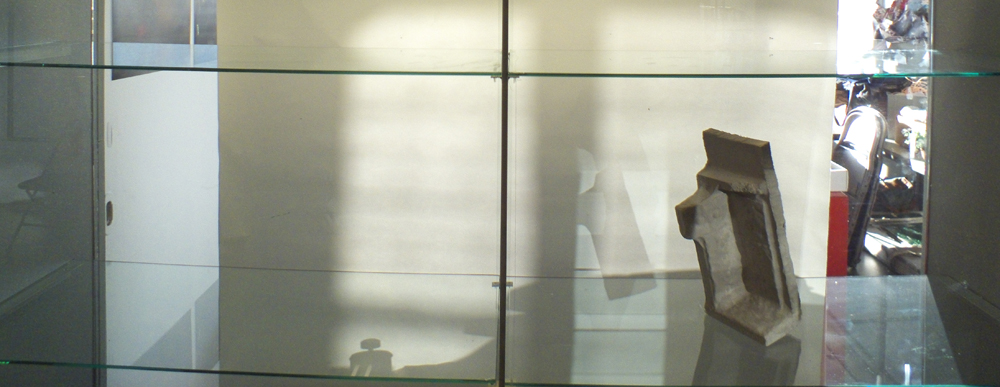
‘Holland in vorm’ geeft je een overzichtelijk beeld van Dutch Industrial Design uit de jaren 90; de periode dat Dutch design vanuit het niets, alom werd geroemd. Dutch design werd een begrip maar bleef, en is nog altijd, moeilijk te ontleden. Want, wat maakt een Dutch design nou zo Hollands? Misschien resulteert een kijkje in de keuken van de meest opvallende en succesvolle Hollandse designers tot antwoord.
Hella Jongerius startte in 1993 haar studio Jongeriuslab, waar zij zowel in eigen beheer als in opdracht van nationale en internationale bedrijven, producten ontwerpt. In de bewuste jaren 90 introduceert Jongerius ambachtelijke imperfecties en individualiteit in productiemethodes. Marcel Wanders brak door in 1996 met zijn Knotted Chair, een stoel van versterkt touw die hij (in samenwerking met de Technische Universiteit Delft) voor Droog Design ontwierp. Droog Design streeft hierin naar werk waarin het concept belangrijker is dan de vormgeving. De producten die hierbij gebruikt worden liggen niet voor de hand, zodat dit gezamenlijk een Hollandse nuchterheid kan uitstralen. En Piet Hein Eek die in een tijd van overdaad, koos voor simpele materialen en een sobere vormgeving zoals zijn boekenkast van sloophout.
Holland in vorm laat moeiteloos zien wat Dutch design nu zou uniek maakt. Uniek blijkt het Nederlandse ontwerpproces. Het delen door middel van ideeën, technologie en materialen, geeft Nederlands ontwerp zijn uiterlijke samenhang. Een uiterlijke samenhang die vaak bestaat uit eenvoud met een grappige twist.
Holland in vorm laat zien dat Dutch design de wereld heeft veroverd.
this post is part of he subjective library project "Unopened Book"
the book can be found at the Rietveld library : catalog no : 772.9-cat-25
Wednesday, March 26, 2008
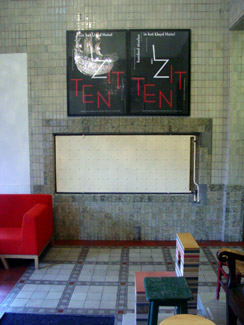
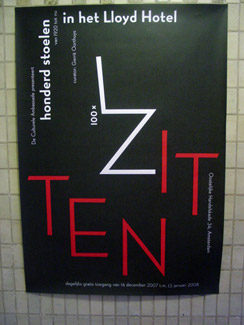
With this typical Gielijn Escher poster a wonderfull collection of 100 chairs was announced. As part of the Lloyd Hotel’s Cultural Embassy program a joint exhibitions was presented of several private chair-collections. This exhibit went beyond its boundries into the intimicy of the hotels floors, rooms and hallways, highlighting their own corporate furniture collection. Gerrit Oorthuys took the initiative of this exhibit and generously showed us around.
Coinciding with the Foundation Year’s January Project Theme “Dull”, we set out to research the origin of a few selected chairs to find out their relation to the motto: original, copy or look-alike. Erik Slothouber (participating in the exhibition with his own designs) lectured on the 2 Rietveld Academies in Amsterdam and Arnhem illustrating the complexity of the choosen motto.
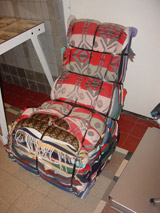
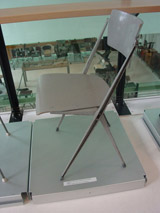
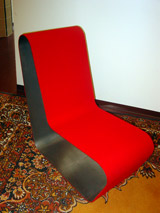
(l>r: Tejo Remy/reclaiming design, Willem Rietveld’s/PYR, Ramin Visch/Eli2006)
Research material was edited down to A4 sized guided tours into selected subjects. All subjects presented in this list are also available as hard copy research prints at the ResearchFolders available at the Rietveld library.
As the two collections represent old and modern classic chairs, it gave us the opportunity to carefully select an interesting designers scala spanning the whole of twentieth century furniture design. Starting with Thonet and architect/interiour designers Mackintosh and De Bazel. Bauhaus professor architect and artist Max Bill was highlighted next to Gerrit Rietveld and the renowned interier shop Metz&Co, through which his furniture icons were often first sold. Erik Slothouber’s lecture connected the early to the late Rietveld and simultaneously presented a link to the architect/designers duo Slothouber & Graatsma. Including the company Rietveld by Rietveld constructed the ideal moebius loop in the “original versus copy” motto.
Including Charles and Ray Eames felt like a must as is Vitra for its museum’s chair collection and chair manufacturing. Don’t forget we were talking about originals versus copies versus look-alikes. The Revolt chair –present in many classrooms of our academy– introduced dutch designer Friso Kramer. Lloyds furniture collection containes many modern designer from which we selected, Tejo Remy, Piet Hein Eek, Jasper Morrisson, Hella Jongerius and Ineke Hans. Finally we added some intriguing subject we coul not resist like: an African stool, poet and craftsman Frits Swart, the poster designer Gielijn Escher and a story about the “zitzak” van Audrey Lai Ng that never saw the daylight.





